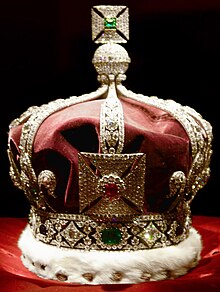Crown Jewels of the United Kingdom
- About the Crown Jewels of England, and those added since the Union of the Crowns in 1603

The collective term Crown Jewels denotes the regalia and vestments worn by the sovereign of the United Kingdom during the coronation ceremony and at other state functions. The term refers to the following objects: the crowns, sceptres (with either the cross or the dove), orbs, swords, rings, spurs, the royal robe or pall, and several other objects connected with the ceremony.[1]
Many of these descend directly from the pre-Reformation period and have a religious and sacral connotation.
The effect of the English civil war[change | change source]

After the death of James I, Charles I came to the throne. His many conflicts with parliament, stemmed from his belief in the divine right of kings. The many religious conflicts in his reign triggered the English Civil War. After six years of war, Charles was defeated and executed by the parliamentarians. Oliver Cromwell became the Lord Protector of England and, less than a week after the king's execution, the monarchy was abolished. The newly created English Republic found itself in a desperate financial state after the war. To raise funds the 'Act for the sale of the personal estate of the King,Queen and Prince' was put forward. Trustees were appointed to value the jewels and sell them to the highest bidder.[2] The most valuable of these objects was the Tudor State Crown, valued at £1,100 (£1,740,000 as of 2011);[3] it was set with 28 diamonds, 19 sapphires, 37 rubies and 168 pearls.[4]
Crowns[change | change source]
The present collection of Crown Jewels contains various crowns, some of which are used by every Sovereign, others being made personally for Sovereigns or for the Queen's Consort. Typically the crown of a King has a slightly pointed arched top, while that of a Queen has a slightly bowed top.
- St Edward's Crown was made in 1661. Many British monarchs find it extremely heavy and difficult to wear.
- The Imperial State Crown was made in 1937 for King George VI, and was similar to the diamond crown made in 1838 for Queen Victoria.

- The Imperial Crown of India was created when King George V visited Delhi as Emperor of India. To prevent the pawning of the Crown Jewels, British law prohibited the removal of a Crown Jewel from the country. For this reason, a new crown was made. It has not been used since. The Imperial Crown of India is not a part of the British Crown Jewels, though it is stored with them.
- The George IV State Diadem was made in 1820 for the coronation of King George IV, and was worn during the coronation processions of Queen Victoria and Elizabeth II.
- Queens consort, the wives of Kings, traditionally wore the crown of Mary of Modena, Queen of King James II. By the beginning of the 20th century, that small crown was in a decrepit state. A new European-style crown, flatter and with more arches than was traditional in British crowns, was made for Queen Alexandra, consort of King Edward VII. A new crown, more like the traditional British crowns, was made for Queen Mary, consort of King George V, who was crowned in 1911. The final new consort's crown in the 20th century was made for Queen Elizabeth, consort of King George VI. Their coronation was in 1937. All three consorts' crowns included the famous Koh-i-Noor diamond.

- The Crown of the Queen Mother is the platinum consort crown manufactured for, and worn by, Queen Elizabeth, the former Lady Elizabeth Bowes-Lyon, the queen consort of King George VI at their coronation in Westminster Abbey in 1937. It is the first crown for a British consort to be made of platinum. The crown was made by Garrard & Co in London, the long term manufacturer of British royal crowns.
The crown is decorated with precious stones, most notably the 105-carat (21 g) Koh-i-Noor diamond in the middle of the front cross.
Koh-i-Noor[change | change source]
The Koh-i-Noor diamond was given to the East India Company by the former rulers of Punjab in 1849.[5] It became part of the British Crown Jewels when Queen Victoria was proclaimed Empress of India in 1877. It also contains the Lahore Diamond (22.48 carats) from the Treasury of Lahore given to Queen Victoria by the East India Company in 1851.[6] and a 17-carat (3.4 g) diamond given to Queen Victoria by the Sultan of the Ottoman Empire in 1856.
The crown is now on display along with the other British Crown Jewels in the Tower of London.[7]
References[change | change source]
- ↑ Official Royal Family website: the Crown Jewels
- ↑ MacGregor, Arthur 1989. The late King's goods: collections, possessions and patronage of Charles I in the light of the Commonwealth Sale Inventories. Oxford.
- ↑ Officer, Lawrence. "Purchasing Power of British Pounds 1264 – present". Measuring Worth. Archived from the original on 2012-04-15. Retrieved 2011-07-11.
- ↑ Millar, Inventories and Valuations of the King's Goods, p. 48.
- ↑ Koh-i-noor: India says it should not claim priceless diamond from UK. BBC News. [1]
- ↑ The Queen’s Jewels: the personal collection of Elizabeth II. Leslie Field & Harry N. Abrams 1987. Times Mirror Books. INBN 0-8109-1525-1
- ↑ The Crown Jewels: the history of the Coronation regalia in the Jewel House of the Tower of London. Kenneth Scarratt 1991. HMSO. ISBN 0-11-701359-5
